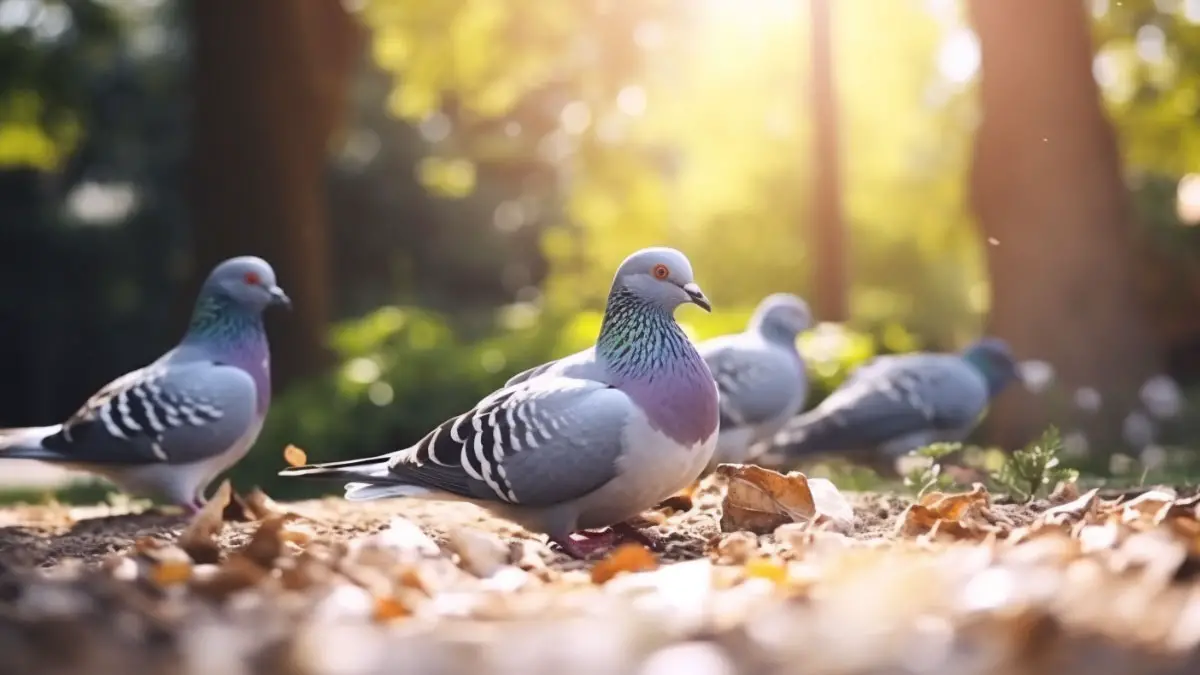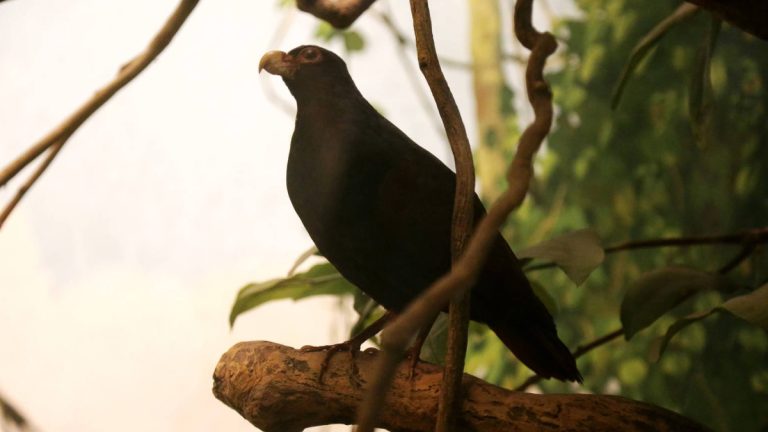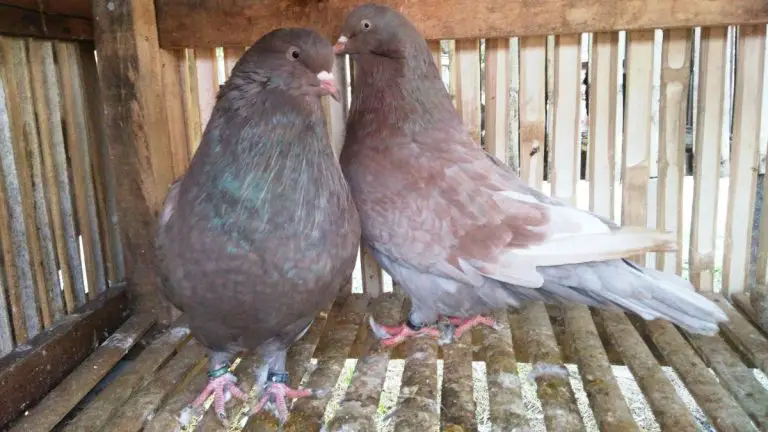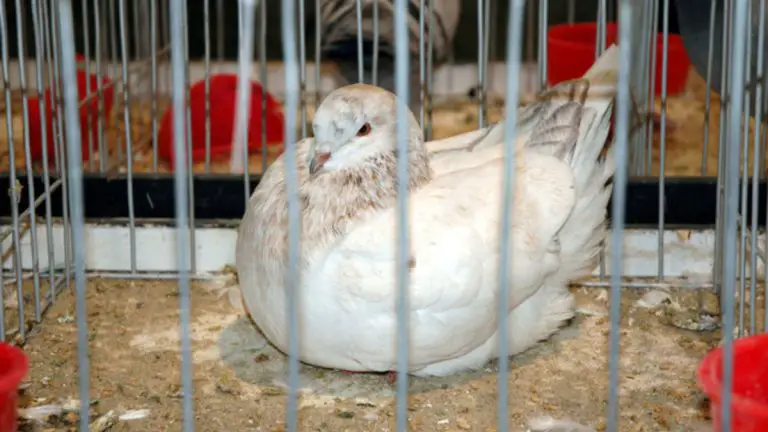17 Most Common Types of Pigeons To Know About
If you’re a budding pigeon fancier or simply a curious mind intrigued by the wonders of nature, you may be wondering what are some of the most common types of pigeons around. Luckily, this guide is for you. Our planet is home to a rich variety of different types and breeds including the wild ones and those kept as pets.
The following article will explore the 17 most common types of pigeons found across the globe ranging from the elegant show birds to the racing champions, native species, and so on. We’ll also share helpful information about the appearance, behavior, habits, etc., of each of these common pigeons.
17 Most Common Types of Pigeons to Know About
Here’s our compilation of the 17 most common types of pigeons in the world that you should know about:
Feral & Wild Pigeons:

Feral pigeons or untamed pigeons are the ones you usually spot in urban or suburban settings. These birds are usually adapted to living in suburbs, cities, or rural areas.
The most common feral pigeons include:
1. Feral rock pigeons
Feral rock pigeons are among the most common types of popular pigeons across the world. They’re simply the descendants of the domesticated pigeons that found their way back into the wild or semi-wild states.
These pigeons can easily be seen foraging in public places or urban areas for bird food. They can also be seen on roosts in public areas such as parks, cities, towns, and various homemade structures.
For this reason, they are commonly referred to as city divers or street pigeons.

Feral rock pigeons come in a wide variety of colors, including black, blue, brown, white, gray, pink/purple, buff, and cream. These birds are around the same size as wild rock doves.
Note that these birds are highly social and are often observed in large flocks, especially in areas that have readily available food sources.
They prefer nesting in abandoned buildings and their favorite foods include cereals, seeds, insects, and human food scraps.
2. Band-tailed pigeons
This is one of the wild types of pigeons. It gets its name from the banded tail it features (usually gray in color).
Another distinctive feature of this pigeon is an iridescent patch at the nape of its neck. Both its beak and feet are yellow in color.
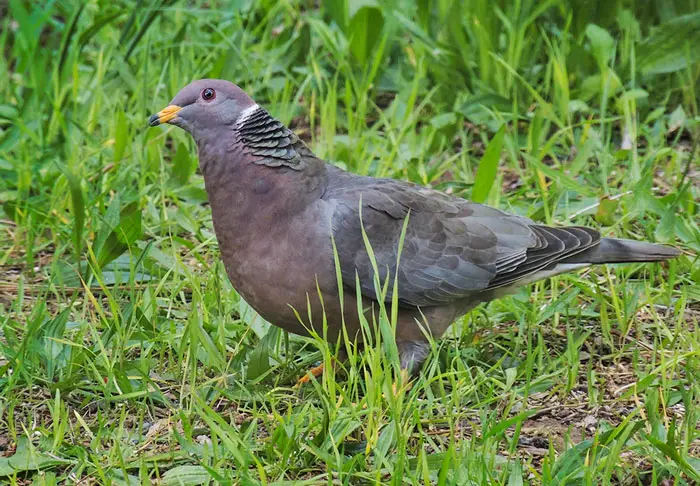
Note that these pigeons do not display significant color variations compared to the feral rock pigeons. They’re also usually large in size, with an average of 14 to 18 inches.
The band-tailed pigeon’s natural habitat is in North American areas and the Pacific coast.
Since these types of pigeons prefer lurking around trees, you will mostly find them in deciduous trees and coniferous forests. They like feeding on acorns, grains, and berries.
3. Mourning dove
Mourning doves are widely recognized and native birds of North America. These birds are known for their gentle, mournful cooing, from which they get their name.
These wild pigeons have soft and muted colors and have pale grayish-brown plumage. Their wings feature black spots and the heads have a distinctive light blue or grayish head.
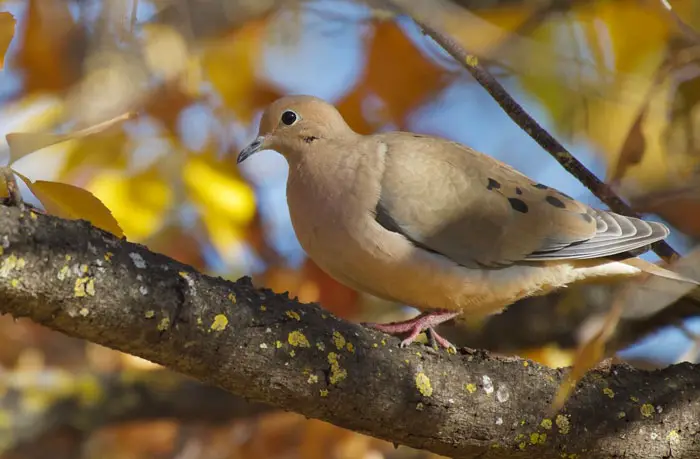
Since these birds are highly adaptable, they’re found in a wide range of environments including suburban areas, urban settings, open woodlands, and even agricultural fields.
Their primary diet consists of seeds, grains, and small insects on occasion. Mourning doves are good foragers and are often seen pecking at grains and seeds on the ground.
4. Wood pigeons
Wood pigeons, also known as common wood pigeons, are another popular species of birds.
Native to the western Palearctic, this bird is usually found in forested areas of Western Asia, Europe, and North Africa.
These pigeons are heavily built and usually larger than other European pigeons. They feature a uniform gray-blue plumage and broad white wing bar.
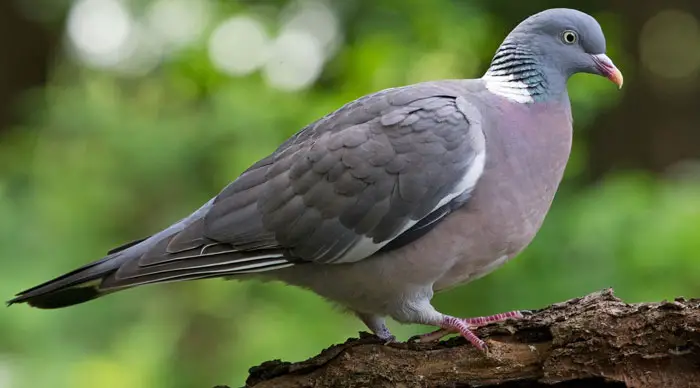
The adults also feature quite a pronounced white patch at the neck side. Not to forget the distinctive white markings on the wings that are easily noticeable when in flight.
Wood pigeons are often spotted perched on trees or foraging for grains, seeds, and other plant materials on the ground.
They also build simple nests in bushes and trees and typically lay up to 2 eggs every breeding season.
Domesticated Pigeons:
The rest of the doves listed below are domesticated pigeons that are kept for different purposes, whether as pets, utility, exhibition (fancy pigeons), or racing and performance birds.
Let’s discuss the most common domesticated pigeons:
5. Homing pigeons
Homing pigeons and racing homers are another highly common type of pigeon in America and in many other parts of the world.
Their most distinguishing feature is muscle strength, excellent flight capabilities, and homing instinct.
The homers are recognized as heroes as they pulled great feats while serving the country during wartime.
Due to their homing ability and great flying capabilities, these birds were used to deliver important messages and help save many lives as a result.
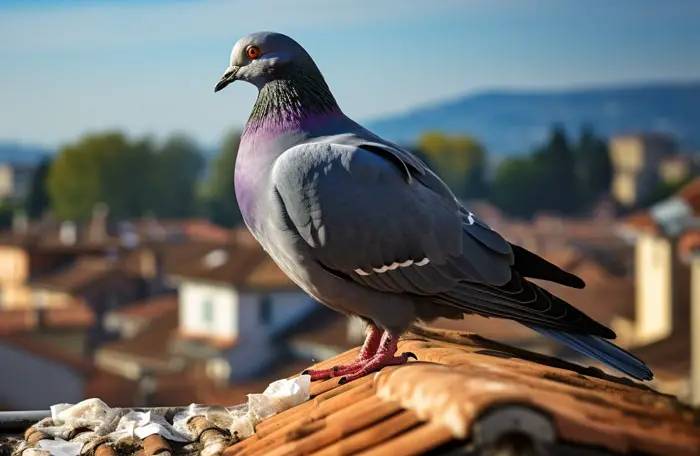
Homing pigeons have such a strong homing instinct that they’ll return regardless of where they have been released from. Depending on the bloodline, some individuals can make it home even from 1000+ miles away.
The homing instinct is still being researched by scientists as it’s an enigma to them.
However, there are claims that these unique birds make use of earth’s magnetic field, the moon, smell, and sound to find their way home.
These birds you see being used in white dove releases events like sports, weddings, funerals, etc., are usually white homers.
However, some people tend to use just any white doves that don’t have homing instincts like these birds.
6. Racing homers
Homing pigeons, thanks to their great flight capabilities and homing instincts, are widely bred for participation in pigeon racing competitions—and are referred to as homing racers.
In terms of appearance, these birds have white or blue plumage, or a combination of both in some cases. They have an average length of 33 to 35 inches.
Typical pigeon racing events involve the birds being released at a given distance, and the one that returns home first is crowned the winner.

The bird owners usually drop off their birds at the club location. From here, they’re put into modified trucks with individual holding components.
They’re driven to an area of release where they’re all set to fly at the same time and they start racing back home (homing instinct at work!)
The homing instinct means these birds can easily return home to their loft when released far away.
Most racing pigeon owners train their pigeons to hone their homing skills and endurance and increase their chances of winning at races.
On returning home, the pigeon owners take the special bands off the birds, which are placed on their legs before the release.
These bands are then inserted in devices that record time and the respective scores are reported to the local club. The bird that takes the fastest time to return home is declared the winner.
Currently, the population of homing pigeons stands at around 3 to 5 billion across the planet!
7. American show racer
This is a special type of homing pigeon developed through crossbreeding of the best racing pigeon breeds. The first American show racer breed was developed in the US back in the 1950s.
The American show race comes in several color variations and has an average length of between 15 and 75 cm.
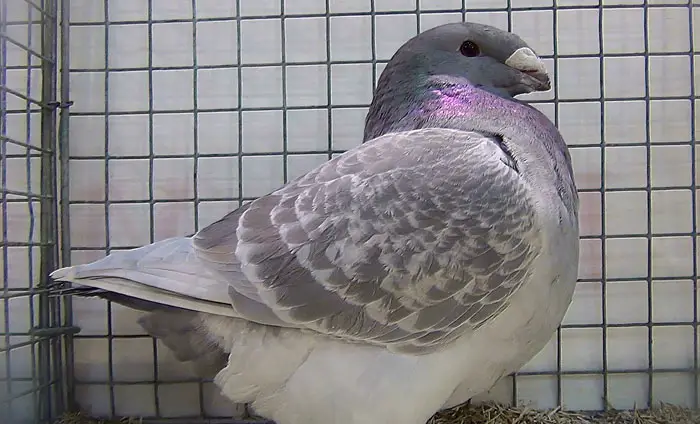
The bird also goes by the name Show Pen Racer and is nicknamed Bird of Dignity. It is usually used on special occasions, e.g. the opening ceremonies of weddings or sporting events.
Besides, it’s also used in racing events, where the standard and finest pigeons like the trippers and racers participate and the winner takes home cash prizes.
8. Tumblers
Tumbler pigeons are show birds that possess the unique ability to roll over or tumble while in flight. They fly normally for the most part but they exhibit intermittent episodes of tumbling.
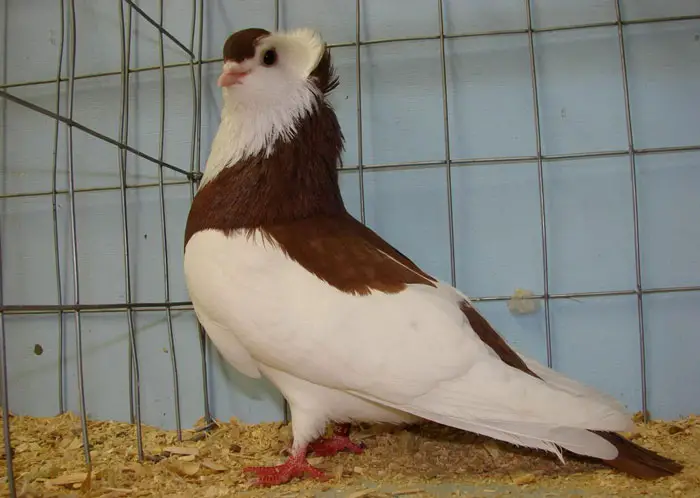
This genetic trait makes these birds popular in pigeon shows and exhibitions in the US and other parts of the world.
Note that there are many recorded breeds of this type of pigeon. Some of the most common varieties include the American flying tumbler, Australian performing tumbler, Berlin tumbler, and Armenian tumbler, among others.
9. Trumpeter pigeons
Trumpeters are a fancy breed that are descendants of rock pigeons. The distinguishing feature of these pigeons is special cooing which sounds like a human’s laughter or trumpeting.
Several varieties exist under this type of pigeon, with each subgroup exhibiting slight color variations and other physical features.
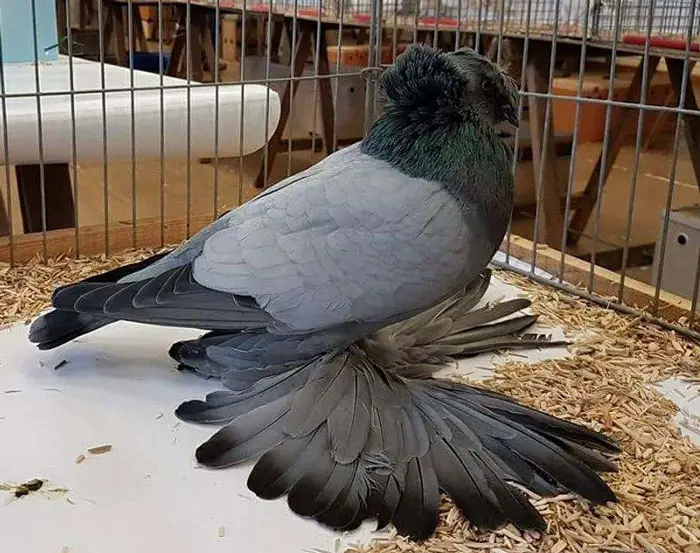
However, all of them still feature the same distinct characteristic of special cooing. The most common colors include yellow, red, and occasionally black.
Some of the most common varieties of trumpeter pigeons include the Arabian trumpeter, Dresden trumpeter, English trumpeter, Altenburg trumpeter, Bokhara trumpeter, and Franconian trumpeter.
10. Pouters
The pouter pigeons are another distinctive fancy breed known for their exaggerated, inflated crops or pouts.
In other words, they have a chest that appears enlarged due to an expanded crop. It has been established that these birds usually inflate their crops as a way of courtship display.
Pouter pigeons come in a variety of colors and patterns. Fanciers like these birds due to their ornamental value.

Most people keep them for exhibition purposes, where the crop inflation capability is a key judging criterion.
Despite puffing up their chests, these birds are quite friendly which makes them popular among bird enthusiasts and hobbyists who want to keep them as pets.
The most common sub-variants of pouters include the Brunner pouter and the English Pouter.
11. Frillback pigeons
These ornamental pigeons are fairly large and feature curly feathers.
The show birds are fair breeders and are not flighty like the flying breeds we discussed earlier. They also usually have an easy personality.
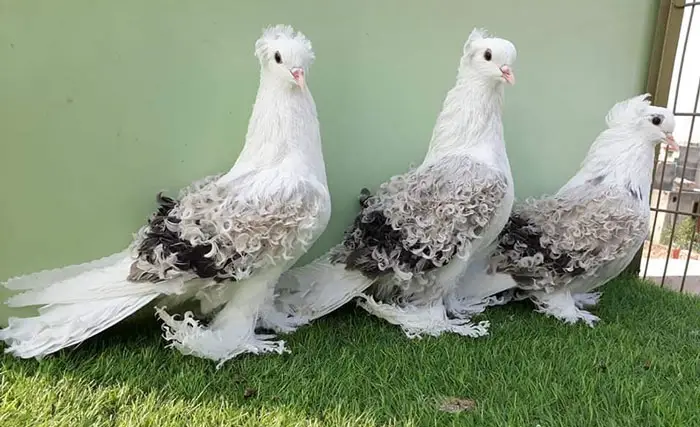
The birds come in varieties with plain heads and those with crests. All frillbacks are muffed.
Frillback pigeons’ ornamental nature means they don’t usually cope well with bad weather and dirt.
12. Modenas
Modenas are big and chubby pigeons that make another type of ornamental breed of pigeons.
Unfortunately, these birds tend to show some level of aggression. So, single-pair breeding is recommended to help minimize conflicts in the loft as low as possible.

Modenas are also not known to be the best of the breeders, though most of them still get along.
If you’re looking for your first breed of pigeons, you may want to keep off Modenas.
13. Archangel pigeons
These are some of the most beautiful fancy pigeons available today. As fancy pigeons, they are mainly kept as pets and are popular in exhibitions and bird shows.
Archangel pigeons usually have a white, black, or blue coloration. Probably their most unique feature is their attractive feathers, which appear as a metallic sheen.
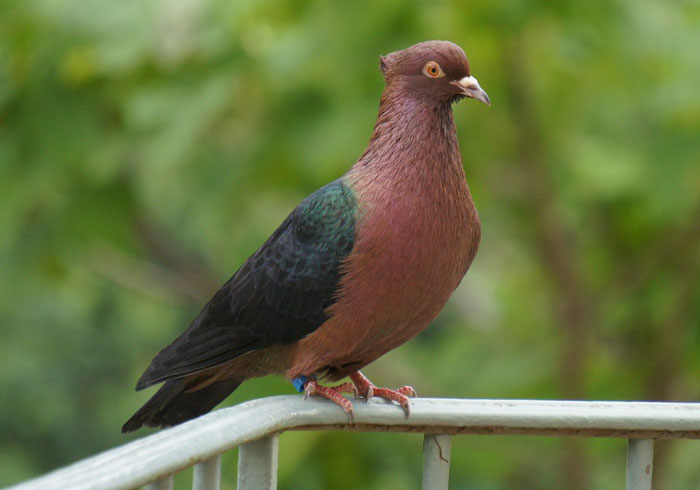
Besides, they also have attractive eyes comprising a dark orange iris.
They also feature a long, narrow, and slightly arched head which can be peak-crested or plain. For the individuals that feature a peak crest, it is usually highly placed in a sharp point.
These pigeons have pretty long wings extending all the way up to the tail. However, they have a relatively smaller body that weighs around 280 to 450g.
14. Capuchine pigeons
This is one of the oldest varieties of fancy pigeons, having originated back in the 16th century. It is believed to have been introduced to India from Holland by Dutch sailors.
Nonetheless, the Capuchine pigeons are a colorful lot and good-looking, which makes them ideal for bird shows and exhibitions.
The bird comes in several color varieties including yellow, black, gray, and red.
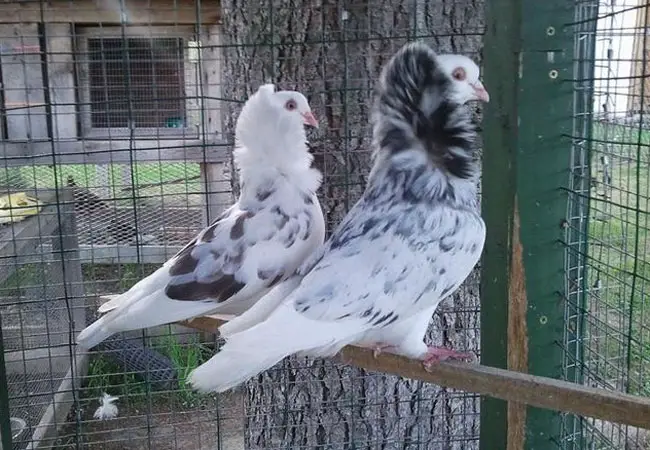
Probably the most unique feature of this type of pigeon is the set of rosettes situated on either side of its neck.
The front of this rosette forms a visible chain that runs down the hood. If you view the bird from the upfront, this chain appears to form a U shape.
15. African owl pigeon
The African owl pigeon is another fancy pigeon that gets its name from its short beak that resembles that of an owl.
These unique pigeons have been bred over years of selective breeding.
The bird originated from Tunisia and was later introduced to England in the 19th century.
One of the distinguishing features of this owl pigeon is a jabot. This is simply a crest of feathers that run down the bird’s chest such that it looks like a tie or a jabot.
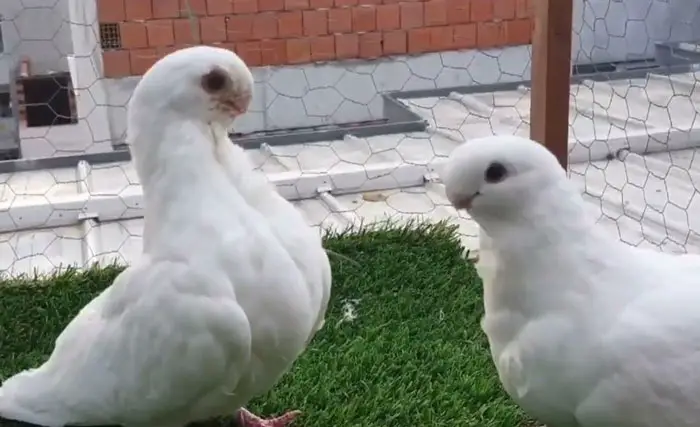
The pigeon also features a smooth head without any unique feather arrangement. It has a plump and short body.
Plus, its beak is pretty small and pointed downward just like that of an owl. They have a light gray color.
16. Fantails
The fantail pigeons are some of the most popular fancy pigeons in the United States and other parts of the world.
They have one key distinctive feature—an extra-large, peafowl or turkey-like tail.
There are two varieties of fantail, namely the Indian fantail and the American fantail.
The former is quite large, has a crest on its head, and has feathers on its feet (muffed). The latter has a smaller size and is plain-headed and clean-legged.
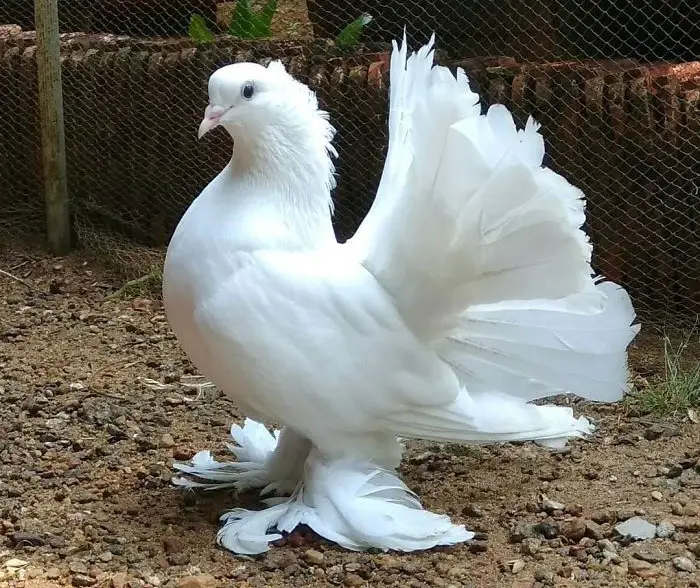
However, keep in mind that these pigeons aren’t recommended for beginner breeders. This is because they have breeding problems usually caused by their large tails, although they can be trimmed.
If you’re not keeping fantails for breeds and just want to keep them as a pet, then they’re friendly birds.
They will make amazing and spectacular avian companions.
Utility Pigeons
Some pigeon breeds are explicitly for food (squab) production. These birds are usually large and fast growers. The most common pigeon kept for squab production is the king pigeon.
17. King Pigeons
Kind pigeons are some of the most common domesticated pigeons and are primarily kept as pets or utility birds (for food, i.e. squab).
These birds usually have a larger body compared to the feral and homing pigeons.
They have pure white plumage and feature pink beaks. They’re friendly, tame, and well-accustomed to human contact.
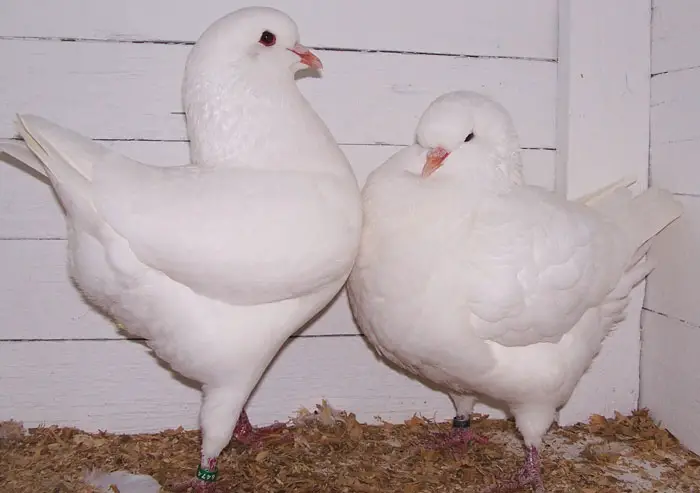
Keep in mind that some folks buy and release these pigeons into the wild as a way of saving them from live animal markets.
Unfortunately, these birds are unable to survive on their own in the wild due to lack of proper fighting and survival skills.
Conclusion
That’s it for our list of some of the most common types of pigeons across the globe. As you can see from this list, domesticated pigeons have been selectively bred for years to help achieve breeds with specific traits and capabilities. As such, different domesticated pigeons serve different purposes such as show birds, racing pigeons, or even utility pigeons.
We hope that this list has given you insights into the different types of pigeons available today. And which ones you may consider keeping as pets or breeding as a beginner pigeon fancier.
